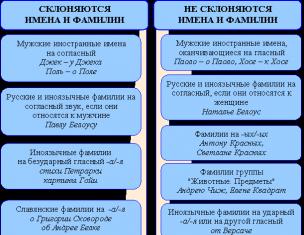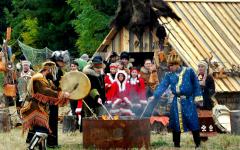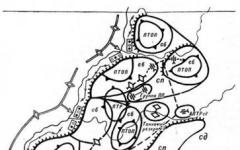In 1812, when the Patriotic War with France began, Ivan Krylov wrote one of the most famous works, “The Wolf in the Kennel.” The cunning wolf is the main character of the fable. At night he entered the kennel, but when the kennel guards discovered him, the wolf invited the guards to negotiate peacefully. However, the kennel guards turned out to be not as naive as the Wolf thought. Not listening to the entreaties of the lying wolf, the watchmen unleashed their dogs on him.
In folk art, wolves have always been considered an example of cunning and deception. The author deliberately chose this beast as the main character in order to show all the deceit and cunning of the enemy.
The story teaches the reader not to trust those who do not keep their word and are constantly cunning. The fable encourages you to think before forgiving a liar, so as not to suffer from your gullibility later.
Picture or drawing Fable Wolf in the kennel
Other retellings and reviews for the reader's diary
- Brief summary of Dumas Dame with camellias
An auction is being held at the home of recently deceased Parisian courtesan Marguerite Gautier to sell off all her belongings and pay off her debts. A man comes to the auction and buys the novel “Manon Lescaut.”
- Summary of Uspensky Clown School
According to the published advertisement, various clowns came, what did they not know how to do! A strict aunt came out and read the first line about how difficult and painstaking training awaits all students. After these words, some of the “loud clowns” were eliminated.
Like a fable, it originated 4000 years ago. A witty allegorical narrative certainly contains the main idea - morality. This genre was introduced and revived into Russian literature by Ivan Andreevich Krylov. If the first fabulists - the ancient Greek author Aesop, the 19th century German writer and playwright Lessing - preferred prose form, then Krylov’s fables were written exclusively in poetry. “The Wolf in the Kennel” is a fable of high patriotic content, written during the Great Year, at the time of the invasion of Napoleonic troops and their inglorious flight from the battlefield.
It is characteristic that in school the study of this work is not always accompanied by reference to a parallel with a historical plot in which there are two main characters: the Hunter - commander Mikhail Ivanovich Kutuzov, the Wolf - Napoleon. Meanwhile, it is in this context that the “moral of this fable” should be perceived. Analysis of the fable “The Wolf in the Kennel” is often done superficially; the work is presented as a fairy tale about an unlucky wolf who, “thinking of ending up in a sheepfold, ended up in a kennel.” An unimaginable noise arose, the dogs were eager to fight, and the Wolf sat in fear, “pressing his back into the corner,” and began to speak flattering speeches about good neighborliness. But the Hunter cannot be fooled: he knows the nature of wolves well, but the world will go, “only by skinning them off.”

Used by I. A. Krylov, they vividly reproduce the atmosphere of military battles, the state of mind of a Wolf caught in a trap, as well as the anger of the inhabitants of the kennel, where an uninvited guest showed up. Is it possible to more vividly describe the confrontation between the defenders of the Motherland and the aggressor, who at the first danger backed down and even tried to make peace - what a wolf in the kennel? A fable is a miniature work that can be compared in significance to an action-packed novel or a historical story.
What is "Wolf in the Kennel" really about? The fable describes the real historical fact during the Patriotic War Realizing that he could not defeat the Russians, the emperor decided to make peace with Kutuzov. However, these negotiations did not take place, and any attempts to make peace would have been doomed to failure. The enemy troops were completely defeated and fled shamefully, freezing in the snows of Russia and losing thousands and thousands of people. This is colorfully and metaphorically written in the satirical picture “Wolf in the Kennel.” The fable was written precisely in the memorable year of 1812.

The fabulist handed over his creation to Kutuzov’s army. History tells that Mikhail Ivanovich, while touring his regiments, would certainly read “The Wolf in the Kennel” to the soldiers by heart. The fable contains the following words: “You are gray, and I, friend, am gray.” At these words, Kutuzov every time took off his cocked hat and showed his gray head. The soldiers' delight and inspiration knew no bounds.
The meaning of this fable is so transparent and obvious that the author did not even accompany it with his traditional explanation - “The moral of this fable is this.” Someone who defends his home and his land cannot be defeated or tricked by any tricks - that’s the whole moral of the fable “The Wolf in the Kennel.” She is timeless. That’s why it remains relevant to this day.
The wolf at night, thinking of getting into the sheepfold, ended up in the kennel. Suddenly the whole kennel yard rose up - Smelling the gray so close to the bully, The dogs poured into the stables and were eager to fight; The hounds shout: “Wow, guys, thief!” - And instantly the gates are locked; In a minute the kennel became hell. They run: some with a club, others with a gun. “Fire!” they shout, “fire!” They came with fire. My Wolf sits with his backside pressed into the corner. With his teeth clicking and fur bristling, with his eyes, it seems he would like to eat everyone; But, seeing what is not here in front of the flock And what is finally coming to Him to pay for the sheep, My cunning man set off
In negotiations And he began like this: “Friends! Why all this noise? I, your old matchmaker and godfather, came to make peace with you, not at all for the sake of a quarrel; Let's forget the past, let's establish a common harmony! And I, not only will not touch the local herds in the future, But I myself am happy to squabble with others for them, And with a wolf’s oath I affirm that I...” - “Listen, neighbor,” Here the hunter interrupted in response, “You are gray, and I, friend, grey-haired, And I’ve known your wolfish nature for a long time; Therefore, my custom is: There is no other way to make peace with wolves than by skinning them.” And then he released a pack of hounds at the Wolf.
Moral of Krylov's fable Wolf in the kennel
And I have long known your wolfish nature; Therefore, my custom is:
There is no other way to deal with wolves than by skinning them.
Morality in your own words the main idea and the meaning of the fable Wolf in the kennel
You cannot take the word of those who have repeatedly deceived and failed to keep their word.
Analysis of the fable Wolf in the kennel
What is a fable? A fable is a lyric-epic work in which the author teaches the reader something. Most often the fable is told in poetic form, and the main ones actors Animals and insects appear in works of this genre. The fable is traditionally divided into 2 parts. In the first, the author conveys the plot of the event that occurred, and in the second, he comes to some conclusion. This conclusion is called morality in the literature. Morals are meant to teach and instruct the reader. I. A. Krylov can without a doubt be called the most famous and beloved Russian fabulist. His works are rightfully included in the golden fund of Russian literature, people love and read them different ages, his collection can be found in every home. One of his most instructive and interesting fables is the fable “The Wolf in the Kennel.” It was written in 1812, at the height of Patriotic War 1812 with France.
She teaches not to take the word of those who have repeatedly deceived and did not keep their word. The fable calls for being cautious and distrustful, so as not to later reap the fruits of your thoughtless forgiveness. It is worth saying that I. A. Krylov chose the Wolf as the main character of his work for a reason. As is known, even in oral folk art, wolves, and along with them foxes, were considered the embodiment of cunning and lies. This image fit perfectly into the plot of the fable and helped the reader understand the moral more fully and accurately.
It is very difficult to determine the rhyme and meter in which the fable is written. This is another one distinguishing feature fables as a genre. However, despite this, the work is still easy to read, in a sing-song manner.
It is also worth noting the historical fact that became the basis of the plot of Krylov’s work. The fable was written in 1812, at the height of the Patriotic War of 1812 with France. It is known that by the image of the Wolf the author meant Napoleon, the commander of the French army, and the watchman who unleashed the dogs on the Wolf is General Kutuzov. This fact also suggests that the fable “The Wolf in the Kennel” is patriotic and filled with love for the Motherland and confidence in its greatness and undoubted victory in this war over the French.
The main characters of the fable (characters) by Ivan Krylov
The main character of the fable is the Wolf. He climbed into the kennel at night, and when he was driven into a corner, he decided to “make a deal” and negotiate peace with the kennel guards. However, the watchmen turned out to be smart enough not to accept the proposals of the cunning Wolf and let the embittered dogs off their leashes with words that are the moral of the whole fable.
Essays on topics:
- The wolf at night, thinking of getting into the sheepfold, ended up in the kennel. Suddenly the whole kennel yard rose up - Smelling the gray one so close to the bully...
- Ivan Andreevich Krylov is an outstanding Russian fabulist. In his works, he castigated liars and scoundrels, serf owners and power-hungers. Genre of fable...
The wolf at night, thinking of getting into the sheepfold,
I ended up at the kennel.
Suddenly the whole kennel yard rose up -
Smelling gray so close to the bully,
The dogs are flooded in the barns and are eager to fight;
The hounds shout: “Wow, guys, thief!”
And instantly the gates are locked;
In a minute the kennel became hell.
They run: another with a club,
Another with a gun.
“Fire!” they shout, “fire!” They came with fire.
My Wolf sits with his backside pressed into the corner.
Teeth snapping and fur bristling,
With his eyes, it seems he would like to eat everyone;
But, seeing what is not here in front of the herd
And what finally comes
He has to pay for the sheep, -
My cunning man set off
In negotiations
And he started like this: “Friends! Why all this noise?
I, your old matchmaker and godfather,
I came to make peace with you, not at all for the sake of a quarrel;
Let's forget the past, let's establish a common harmony!
And not only will I not touch the local herds in the future,
But I’m happy to fight for them with others
And I affirm with a wolf’s oath,
What am I...” - “Listen, neighbor, -
Here the hunter interrupted in response, -
You are gray, and I, buddy, are gray,
And I have long known your wolfish nature;
Therefore, my custom is:
There is no other way to make peace with wolves,
Like skinning them off.”
And then he released a pack of hounds at the Wolf.
Summary
The wolf wanted to sneak into the sheepfold at night, but suddenly he ended up in the kennel. Of course, they sensed a stranger and stood up, as if on command. The dogs barked and were eager to fight. The hounds decided that a thief had appeared. That's why they locked the gate. There was a commotion in the kennel. Someone was rushing with a baton, someone with a gun. Others asked for fire. When the fire appeared and the light was shining, the Wolf became visible, huddled in the corner. He bared his teeth, his fur stood on end. He was ready to rush into battle, but he understood that he could not win. He understood that retribution would follow, so for the sake of cunning he arranged negotiations. He stated that he was a relative and came not to quarrel, but to make peace. He asked not to remember the past and live peacefully. For his good attitude towards him, he promised not to attack the local herds, but to be a guard for them. He agreed to swear. However, the wise hunter, well acquainted with the wolf’s nature and the value of his promises, interrupted the Wolf and announced that he was used to not trusting wolves and not agreeing to make peace with them, but was only skinning wolves. After this he released the hounds.
Fable Analysis
History of creation
The fable “The Wolf in the Kennel” was created by I. A. Krylov in response to Napoleon’s attempts in September 1812 to negotiate a truce with Kutuzov. As you know, the Russian commander-in-chief decisively rejected peace proposals and in early October won a decisive victory at Tarutino.
Kutuzov received the text of the fable in a letter from his wife and personally read it to the officers after the Battle of Krasnoye. After reading the line “and my friend is gray,” the commander took off his headdress and showed off his own gray head.
Meaning of the name
Krylov openly hints at the hopeless situation of Napoleon, who was like a wolf caught in Kutuzov’s trap.

The main theme of the work
The main theme of the work is a decisive and merciless struggle against the aggressor.
Before his campaign in Russia, Napoleon practically knew no defeats. The French army easily defeated any enemy. Napoleon confidently believed that Russia would become an equally easy prey, but he was severely mistaken in his calculations. In the same way, the wolf mistakenly ends up in the kennel instead of the sheepfold.
Finding himself in a hopeless situation, the wolf (Napoleon) tries to get out of the situation with the help of promises. However, the hunter (Kutuzov) knows what the price is for the wolf’s false promises. A predator remains a predator. He cannot be trusted and cannot be forgiven. The only reasonable way out is to release “a pack of hounds against the Wolf,” which is what Kutuzov does, starting the pursuit of the remnants of the army of the “great conqueror.”
Issues
After the Battle of Borodino and retreat French army From Moscow it became clear to Napoleon that the campaign had already been lost. According to the traditional "rules of war" it was necessary to sign a truce. There were also supporters of this point of view on the Russian side.
Alexander I and Kutuzov were faced with the problem of a further plan of action. Krylov gives an unambiguous solution: the invading enemy does not deserve any mercy.
The composition of the fable is consistent. At the end, a general moralizing conclusion is given.
Morality
Krylov allegorically addresses the patriotic theme. If Napoleon compared the campaign to Russia with an unsuccessful chess game, for the Russian people it turned into thousands of civilian casualties, destroyed and burned cities, and humiliation from the capture of the capital. All this required merciless revenge on the presumptuous “wolf.”
This point of view fully met the aspirations of the population Russian Empire. K. Batyushkov wrote that “The Wolf in the Kennel” and other patriotic fables by Krylov “in the army... everyone reads them by heart.”








